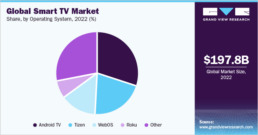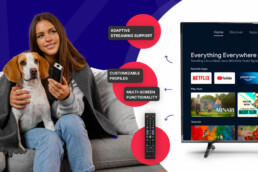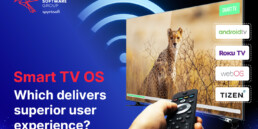As a party looking to venture into the world of Smart TV apps, understanding what makes the successful ones stand out from the crowd and appeal to users is crucial. More and more possibilities in the realm of Smart TV solution development emerge each day. Service providers can take advantage of enhanced Smart TV features that make streaming a seamless and engaging experience.
Understanding the Smart TV market: Insights and trends
Navigating the complexities of the Smart TV technological market requires a broad understanding of factors that impact this rapidly changing sector. When we take a broader look at this industry, what becomes clear is its foundations lie not in software or devices. As important as they are, all of their functionalities are shaped because of consumer preferences, economic influences and market trends. In short, the Smart TV market is a building ground for ideas, development and innovation highly influenced by the principle of reaching end-user satisfaction. Having this overview gives us a clearer perspective of the industry, critical when thinking of joining it.
Market growth

Even a quick look at the broadly available data reveals proof of rapid development and expanding opportunities within the Smart TV sector. Research provided by Grand View Research underlines this trend stating that the global Smart TV market size was valued at $ 197.82 billion in 2022. Even more importantly, it is expected to expand at a compound annual growth rate of 11.4% from 2023 to 2030. The report gives additional context into what could be the leading factors for such a surge in demand. One of them is that content owners and creators are diversifying their offerings and including different genres to meet every user demand possible. This growth is also driven by the increasing interest in accessing high-definition content, which has become possible due to technological improvements not only in its production but also in device display.
Competitive landscape
The Smart TV market is characterized by intense competition among streaming and OTT service providers. The fight for the attention of users drives all players to deliver the most engaging and innovative apps possible. Major companies are not only looking to score the top place but competie on several levels from content variety to the integration of advanced Smart TV features. Emerging solution owners look for user engagement in niche areas and specialized content often utilizing more unique options. Ones that match their style and help them not only spark the user interest and stand out from the crowd but also keep the retention rate high. This competition fosters innovation and market diversification, and understanding its nature is key to identifying gaps and opportunities in the Smart TV landscape.
Consumer preferences
Consumers increasingly favor apps that offer not only a wide range of content but care for the personalization aspect of viewing experiences. The preferences shift towards intuitive interfaces and easy navigation that provide seamless access to the content of choice. Moreover, users opt for solutions that are highly interactive and immersive with enhanced viewing options. Staying on top of user preferences and interests provides invaluable information and helps us understand the importance of innovative Smart TV features in streaming/OTT design.
Technological advancements
Advancements in the technological realm have a high impact on the evolution of Smart TV features and overall applications. They are vital to the improvement of the overall quality of video and audio streaming. New technologies are advancing the core functionalities of solutions and elevating the quality and versatility of user experiences. Technological progress is the force that drives dynamic changes in the Smart TV market, encouraging service providers to seek more innovative and adaptable features.
7 Smart TV features that enhance the Smart TV streaming experience
As we delve deeper into the intricacies of the Smart TV market the importance of crucial Smart TV features in delivering a seamless streaming experience becomes evident. These features not only have an impact on the functionality of the Smart TV system but also define the overall user experience.
Here is a list of 7 types of Smart TV features that are worth taking into account by investors considering this space wanting to ensure smooth and engaging streaming for viewers:
1. Integrated Payment Systems
In-app payment systems have revolutionized and simplified how users make transactions within platforms while simultaneously offering an important advantage for solution owners. The use of integrated payment systems significantly shortens the path to finalizing transactions, which facilitates purchases and enhances the user experience. Such seamless integration allows for the diversification of revenue streams supporting various monetization strategies.
2. Customizable User Profiles
The ability to create and manage multiple user profiles within smart TV apps is a significant feature. It allows for the implementation of crucial management strategies and content control. From the perspective of users, the biggest advantages are personalized content recommendations and unique viewing experiences, which can increase user engagement and loyalty. This personalization is also valuable for targeted advertising and marketing strategies.
3. Multi-Screen Functionality
Multi-screen Smart TV allows content to be seamlessly cast or shared between devices, which provides a more integrated and flexible viewing experience. This feature can enhance the appeal of an app and complement the overall functionality. Moreover, multi-screen support opens up numerous opportunities for advertising and interactive content, when users can interact with the app on one device and watch content on another.
4. Robust Security Features
Security features for Smart TV apps are vital with increasing concerns about data security and privacy. Adhering to proper security measures not only safeguards user data from unauthorized access and breaches but also protects the functionality of the whole system. On top of that, apps that prioritize user data protection foster trust and credibility among users which are key factors in developing the brand’s reputation.
5. High-Quality Content Streaming
In today’s market standards high-quality streaming, encompassing both video and audio, is essential in providing Smart TV services. Features that support ultra-high-definition (UHD) and high dynamic range (HDR) content ensure that the app can deliver the best possible experience. Viewers expect almost cinematic qualities accessible from the comfort of their own homes and premium visual quality is a major selling point.
6. Resolution and Aspect Ratio Adaptability
The variety of screen sizes and resolutions (from HD to 4K and even 8K displays) in smart TVs means apps need to adapt and scale their content without losing quality. This flexibility is crucial to maintaining the integrity of displayed images and interfaces. Features that allow apps to adjust their resolution and aspect ratio ensure a consistent and optimal user experience across various TV models.
7. Adaptive Streaming Support
In order to create seamless and uninterrupted viewing experiences the app has to possess the ability to adapt to the changing bandwidth and different device capabilities. Smart TVs often support adaptive streaming technologies like HLS (HTTP Live Streaming) and MPEG-DASH. This allows apps to automatically adjust the video quality based on the user’s internet speed, ensuring smooth playback. Taking different environments into account ensures a stable user experience and efficient resource utilization.
Future trends in Smart TV features
As we look to the future, the changes in Smart TV app operations will be of significance when thinking of shaping our viewing habits. We’re likely to see improvements and inclusion of AI technologies into the world of Smart TV features. There is also significant potential in augmented and virtual reality that can reshape how we view user engagement and interaction. Additionally, due to the immense expansion of IoT (Internet of things) technologies, Smart TVs are expected to become even more integrated with other smart devices acting as central hubs for home connectivity. Another significant trend will be the focus on sustainability and energy efficiency, a reaction to growing customer demand for greener solutions. These growing trends indicate a new complex and aware approach to designing Smart TVs and their features, one that underlines the continuous evolution based on market changes and consumer preferences. Check out our detailed site on Smart TV app development for more information.
Understanding the importance of Smart TV features
Including these features in any streaming application is vital for all looking to make a mark in the smart TV app market. They not only enhance the user experience but also offer various avenues for monetization and brand development, making them key considerations for strategic investment in this space.
If you find this article valuable, you can share it on social media →
Read more about the Smart TV applications!
February 20, 2024
What is Titan OS and what do we know about it so far?
Explore what distinguishes Titan OS, a new smart TV operating system. Discover its unique features before giving it a try yourself.
January 30, 2024
Smart TV operating systems: which offers the best user experience?
Discover the best Smart TV operating systems in our expert analysis. Compare top platforms, focusing on user experience.
December 15, 2022
Smart TV, Roku and Chromecast Explained
Ever wondered what's the difference between Smart TV, Roku, and Chromecast? We've got you covered!
Are you looking for a partner to build an application on Smart TV?
Leave your email and a short description about your project. We would gladly discuss different cooperation possibilities!





